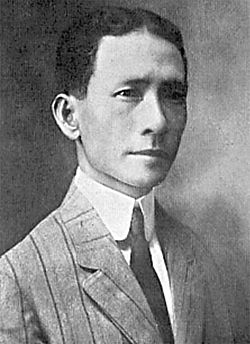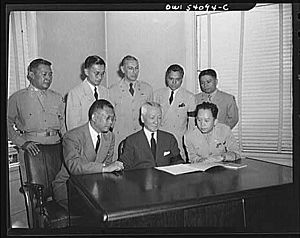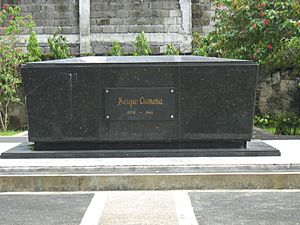Sergio Osmeña facts for kids
Quick facts for kids
Sergio Osmeña
CCLH
|
|
|---|---|
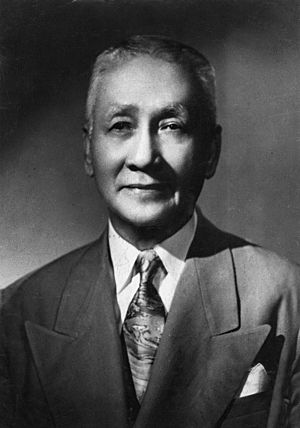 |
|
| 4th President of the Philippines | |
| In office 1 August 1944 – 28 May 1946 Serving with Jose P. Laurel (1944–1945)
|
|
| Vice President | None |
| Preceded by | Manuel L. Quezon José P. Laurel |
| Succeeded by | Manuel Roxas |
| 1st Vice President of the Philippines | |
| In office 15 November 1935 – 1 August 1944 |
|
| President | Manuel L. Quezon |
| Preceded by | Position established |
| Succeeded by | Elpidio Quirino |
| Secretary of Public Instruction, Health, and Public Welfare in concurrent capacity as Vice President of the Philippines |
|
| In office 24 December 1941 – 1 August 1944 |
|
| President | Manuel L. Quezon |
| Preceded by | Juan Nolasco Jorge Bocobo |
| Succeeded by | Mariano Eraña Basilio Valdes Carlos P. Romulo |
| Secretary of Public Instruction in concurrent capacity as Vice President of the Philippines |
|
| In office 1935–1940 |
|
| President | Manuel L. Quezon |
| Preceded by | Unknown |
| Succeeded by | Jorge Bocobo |
| 2nd Senate President pro tempore of the Philippines | |
| In office 1922–1934 |
|
| Preceded by | Esperidion Guanco |
| Succeeded by | José Clarín |
| Senator of the Philippines from the 10th district | |
| In office 6 June 1922 – 15 November 1935 Serving with
Celestino Rodriguez (1922–1925) Pedro Rodriguez (1925–1931) Manuel Briones (1931–1935) |
|
| Preceded by | Filemon Sotto |
| Succeeded by | Position abolished |
| 1st Speaker of the Philippine House of Representatives Speaker of the National Assembly (1907–1916) |
|
| In office 16 October 1907 – 11 February 1922 |
|
| Preceded by | Office created |
| Succeeded by | Manuel Roxas |
| Member of the Philippine House of Representatives from Cebu's 2nd district Member of the National Assembly (1907–1916) |
|
| In office 16 October 1907 – 6 June 1922 |
|
| Preceded by | Office created |
| Succeeded by | Vicente Sotto |
| 3rd Governor of Cebu | |
| In office 1904 – 16 October 1907 |
|
| Preceded by | Juan F. Climaco |
| Succeeded by | Dionisio A. Jakosalem |
| Personal details | |
| Born | 9 September 1878 Cebu, Cebu, Captaincy General of the Philippines |
| Died | 19 October 1961 (aged 83) Quezon City, Philippines |
| Resting place | Manila North Cemetery, Santa Cruz, Manila, Philippines |
| Political party | Nacionalista |
| Spouses |
Estefania Veloso
(m. 1901; Esperanza Limjap
(m. 1920) |
| Children | 13 (including Sergio Jr.) |
| Alma mater | Colegio de San Juan de Letran (AB) University of Santo Tomas (LL.B) |
| Profession | Lawyer, soldier |
| Signature | |
| Military service | |
| Allegiance | First Philippine Republic Philippine Commonwealth |
| Branch/service | Philippine Revolutionary Army Philippine Commonwealth Army |
| Years of service | 1899–1900 1941–1945 |
| Rank | Commander-in-Chief |
| Battles/wars | Philippine–American War World War II * Philippines Campaign (1941–1942) * Japanese Occupation of the Philippines (1942–1945) * Philippines Campaign (1944–1945) |
Sergio Osmeña Sr. (born September 9, 1878 – died October 19, 1961) was an important Filipino leader. He served as the fourth President of the Philippines from 1944 to 1946. Before that, he was the Vice President under Manuel L. Quezon.
When President Quezon sadly passed away in 1944, Osmeña became president at 65 years old. This made him the oldest person to become president of the Philippines until 2016. He helped start the Nacionalista Party and was the first president from the Visayan region.
Before becoming president, Osmeña held many important roles. He was the governor of Cebu from 1906 to 1907. He was also the first Speaker of the Philippine House of Representatives from 1907 to 1922. Later, he served as a senator for 13 years. In 1935, he became Vice President alongside Manuel L. Quezon, and they were re-elected in 1941.
Sergio Osmeña Sr. was the head of the famous Osmeña family. Many of his family members also became important politicians, including his son, Sergio Osmeña Jr., and his grandsons, Sergio Osmeña III and John Henry Osmeña.
Contents
Early Life and Education
Sergio Osmeña was born on September 9, 1878, in Cebu. His mother was Juana Osmeña y Suico. The Osmeña family was a rich and well-known family in Cebu with Chinese Filipino roots.
He went to elementary school at the University of San Carlos. In 1892, he moved to Manila for more schooling. He studied at San Juan de Letran College, where he met Manuel L. Quezon, who would later become a close friend and political partner.
Osmeña then studied law at the University of Santo Tomas. He did very well, placing second in the bar exam in 1903. During the Philippine–American War, he worked as a messenger and journalist for General Emilio Aguinaldo. In 1900, he started a newspaper in Cebu called El Nuevo Día (The New Day).
Starting Public Service in Cebu
Osmeña began his public service career in Cebu. When the governor of Cebu, Juan Climaco, traveled for an expedition, Osmeña was chosen to be the acting governor. After Climaco returned, Osmeña became a provincial prosecutor.
His work as prosecutor helped him gain recognition. In 1906, he was elected as the governor of Cebu. This was an important step in his political journey.
Working in Congress
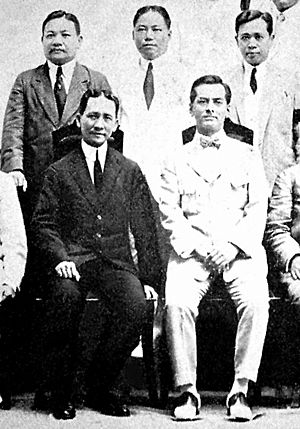
While he was still governor, Osmeña ran for a seat in the first Philippine Assembly in 1907. He was elected as its very first Speaker. At only 29 years old, Osmeña was already the highest-ranking Filipino official.
He and Manuel L. Quezon from Tayabas created the Nacionalista Party. This party was formed to challenge other political groups at the time.
Speaker of the House of Representatives
As Speaker, Osmeña led the assembly in trying to pass laws that often disagreed with the American leaders in the Philippine Commission. Some important bills that were rejected included:
- A bill to remove the sedition law, which punished Filipinos who spoke about independence.
- A bill to remove the flag law, which banned showing the Filipino flag.
- A bill to give more power to local governments.
Even though some bills were rejected, the assembly under Osmeña still passed important laws. These laws helped the Philippine legislature share some power with the American governor-general.
Working with Manuel Quezon
Osmeña and Manuel L. Quezon were good friends and classmates. Quezon was the majority floor leader when Osmeña was Speaker. When the Jones Law was passed, Quezon became the Senate President, and Osmeña continued as Speaker.
Becoming a Senator
In 1922, Osmeña was elected to the Senate. He represented the 10th senatorial district. He traveled to the United States in 1933 as part of the OsRox Mission. Their goal was to get a law passed that would grant the Philippines independence. This led to the Tydings–McDuffie Act in 1934.
Serving as Vice President
In 1924, Quezon and Osmeña worked together again. Their Nacionalista Party became very strong. In 1935, Quezon and Osmeña ran together in the first national presidential election in the Philippines. They won by a large margin.
They were sworn into office on November 15, 1935. In 1940, the constitution was changed, allowing Quezon to run for re-election. In the 1941 elections, Quezon and Osmeña won again.
When World War II started and Japan invaded the Philippines, the government had to go into exile. Osmeña remained Vice President during this time. He also served as Secretary of Public Instruction from 1935 to 1940, and again from 1941 to 1944.
Becoming President During Wartime
By 1943, the Philippine government-in-exile faced a challenge. President Quezon's term was supposed to end on December 30, 1943. According to the constitution, Vice President Sergio Osmeña would then become president.
Osmeña brought this up with Quezon. Quezon felt it wasn't a good time to change leaders because of the war. They asked the U.S. Attorney General for an opinion, who agreed with Osmeña.
Finally, Osmeña suggested asking the U.S. Congress to temporarily stop the rule about presidential succession. This way, Quezon could continue as president until the Philippines was free. Both Quezon and the Cabinet agreed to this plan. The U.S. Congress approved this idea in November 1943.
Presidency of Sergio Osmeña
| Presidential styles of Sergio Osmeña |
|
|---|---|
| Reference style | His Excellency |
| Spoken style | Your Excellency |
| Alternative style | Mr. President |
Osmeña became president of the Commonwealth after President Quezon's death in 1944. He took his oath of office in Washington, D.C. He returned to the Philippines later that year with General Douglas MacArthur and the American forces that were liberating the country.
After the war, Osmeña worked to bring back the Commonwealth government. He continued to push for the Philippines to become fully independent. In the 1946 presidential election, Osmeña chose not to campaign. He believed that Filipinos knew his long record of honest service. He lost the election to Manuel Roxas, who became the first president of the independent Republic of the Philippines.
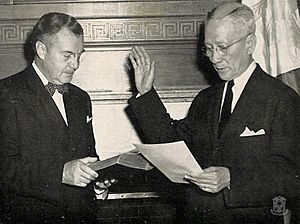
Liberating the Philippines
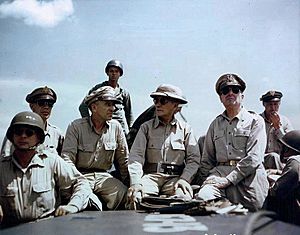
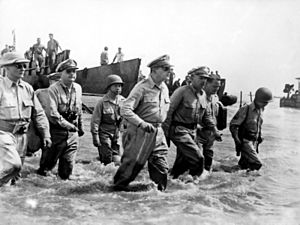
President Osmeña was with U.S. General Douglas MacArthur when American forces landed in Leyte on October 20, 1944. This landing marked the start of the liberation of the Philippines from Japanese occupation during World War II. Once the American forces secured the area, General MacArthur immediately gave authority back to Osmeña as the Philippine Commonwealth president.
Restoring the Government
After Manila was freed, General Douglas MacArthur officially handed over the government of the Philippines to President Sergio Osmeña on February 27, 1945. This ceremony took place at the Malacañang Palace. Osmeña thanked the United States and announced that the Commonwealth of the Philippines government was back in charge. He then focused on helping the Philippines recover from the war.
Osmeña quickly began to reorganize the government. On April 8, 1945, he formed his Cabinet. He also met with the Council of State to get help with the big problems facing the country. Government offices and departments were slowly reopened. New ones were also created to meet the needs of the time. The Supreme Court of the Philippines and other courts were also brought back. As more parts of the country were freed, provincial and city governments were set up again.
Economic Recovery Efforts
After the Commonwealth government was restored, the Philippine Congress was also reorganized. President Osmeña spoke to Congress and talked about the government-in-exile. He also suggested important new laws.
The first law passed was Commonwealth Act No. 672. This law helped to bring back the Philippine National Bank. This was a key step in rebuilding the country's economy.
Dealing with War Collaborators
To address the issue of people who had worked with the Japanese during the occupation, Congress passed Commonwealth Act No. 682 on September 25, 1945. This law created the People's Court and special prosecutors to handle these cases.
International Relations
Joining the United Nations
Osmeña sent a Philippine group, led by Carlos P. Romulo, to San Francisco on June 26, 1945. They were there for the creation of the Charter of the United Nations. The Philippines was one of the 51 countries that helped write the UN Charter. The Philippine Congress approved the Charter, and it was officially given to the U.S. State Department on October 11, 1945.
Setting up Foreign Relations
To get ready for the Philippines to become independent, Osmeña created the Office of Foreign Relations. Vicente Sinco was appointed as its first head. Osmeña also made an agreement with the United States government to send five Filipinos to train at the U.S. State Department. This training would prepare them for diplomatic service, working in embassies and consulates in other countries.
Joining International Banks
On December 5, 1945, Osmeña appointed Carlos P. Romulo to represent the Philippines. Romulo accepted the Philippines' membership in the International Monetary Fund and the International Bank for Reconstruction and Development. These organizations were created by the Bretton Woods Agreement, which the Philippines had also been a part of.
The Bell Trade Act
On April 30, 1946, the United States Congress approved the Bell Act. This act was important for the Philippines' economy after the war. Osmeña and Carlos P. Romulo had strongly pushed for this bill to be passed.
The Act allowed the Philippines to trade freely with the United States for eight years. After that, taxes on goods would slowly increase over 20 years. The law also set limits on how much of certain products, like sugar and coconut oil, could be sent to the U.S. This aid, along with money for war damages, helped the Philippines rebuild.
The 1946 Presidential Election
After the Commonwealth government was restored in 1945, some senators called for an early national election. This election would choose the president, vice president, and members of Congress. In December 1945, the U.S. Congress approved a plan to hold the election by April 30, 1946.
Osmeña then called the Philippine Congress for a special meeting. Congress passed a law setting the election date for April 23, 1946. Osmeña signed this law on January 5, 1946.
Three main groups presented candidates for the election:
- The Nacionalista Party (Osmeña's group)
- The Liberal wing of the Nacionalista Party
- The Partido Modernista
The Nacionalistas chose Osmeña for president and Senator Eulogio Rodriguez for vice president. The Liberals chose Senators Manuel Roxas and Elpidio Quirino. Osmeña announced he would run for re-election on January 3, 1946.
There was a split within the Nacionalista Party. Osmeña tried to prevent this split by offering Senator Roxas a position in the United States, but Roxas declined. This led to the formation of a new political group, the Liberal wing of the Nacionalista Party, which later became the Liberal Party.
The election was mostly peaceful. Over 2.2 million people voted to choose the last president and vice president of the Commonwealth, who would also be the first leaders of the independent Republic. Four days after the election, the Liberal Party candidates, Manuel Roxas and Elpidio Quirino, were declared the winners. Roxas won a large majority of votes across many provinces and cities.
The Liberal Party also won most of the seats in the Philippine Senate and the House of Representatives.
Life After Presidency and Passing
After losing the election, Sergio Osmeña retired to his home in Cebu. He passed away on October 19, 1961, at the age of 83. He died from a lung condition at the Veterans Memorial Medical Center in Quezon City. He was laid to rest at the Manila North Cemetery in Manila on October 26, 1961.
Osmeña's Family
His Marriages and Children
- On April 10, 1901, Sergio Osmeña married Estefania Chiong Veloso. They had ten children together: Nicasio, Vicenta, Edilderto, Milagros, Emilio, Maria Paloma, Jesus, Teodoro, José, and Sergio Osmeña Jr..
- In 1920, two years after his first wife passed away, Osmeña married Esperanza Limjap. They had three more children: Ramón, Rosalina, and Victor.
Notable Descendants
Many of Sergio Osmeña's descendants also became important political figures:
- Sergio Osmeña Jr., his son, who was a former Senator.
- Sergio Osmeña III, his grandson, who was also a former Senator.
- John Henry Osmeña, another grandson, who served as a congressman, senator, and mayor.
- Tomas Osmeña, his grandson, who was a former Mayor of Cebu City and congressman.
- Emilio Mario Osmeña, his grandson, who was a former governor of Cebu.
- Rogelio Veloso Osmeña, his grandson, who was a former Councilor of Cebu City.
- Renato Veloso Osmeña, his grandson, who was a former Vice Mayor of Cebu City.
Images for kids
See also
 In Spanish: Sergio Osmeña para niños
In Spanish: Sergio Osmeña para niños


